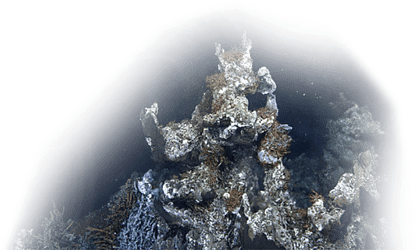It’s hardly been a case of “all play and no work” for Wally the Crawler. Researchers in Germany and Canada have been making heavy use of Wally and the unique data this deep-sea crawler gathers among the gas hydrates outcrops of Barkley Canyon.
A recent paper published in the journal Geophysical Research Letters details their recent findings, which have implications for changes we may expect as Earth’s climate warms.
Wally the Crawler sits atop some gas hydrates in Barkley Canyon.
Seabed gas hydrates are found in zones where high pressures (60+ atmospheres) and low temperatures (below 4° C) cause ice-like methane deposits, called hydrates, to form within the sediments. Vast volumes of hydrates are known to lie buried beneath the seafloor along continental margins throughout the world. The methane locked within these deposits is regarded both as a potential energy source and as a greenhouse gas; if released into the atmosphere, methane could play a role in accelerating climate change because it is 20 times more efficient at trapping heat in the atmosphere than carbon dioxide.
A major challenge in ocean research is the quest to determine how much methane escapes these deposits, what happens when it mixes into the overlying ocean waters, how much of a seafloor release is likely to enter the atmosphere, and how these processes might be influenced by climate change.
Hydrate mound in Barkley Canyon.
Wally is helping scientists delve into these elusive, yet critically important questions. Equipped with a methane sensor and current meter, Wally was positioned at various locations within the hydrates field, gathering a 24-month long collection of data. Throughout this study period, Wally’s video camera was used to monitor changes in the microbial mats and related fauna that are based on the methane food source. Parts of a mound were seen to grow, shrink and collapse, while bacterial mats disappeared and reappeared as supplies of hydrocarbons (food for bacteria) shrank and grew.
Map of Wally Land in the Barkley Canyon gas hydrates.
The research team found that methane release increased when currents at the bottom of the ocean strengthened. Storm-driven inertial motions, tidal currents, and internal waves drive such currents, which appear capable of “scouring” exposed gas hydrate deposits. Scientists now want to know whether this scouring action and methane release rates will increase as mid- and high-latitude storms intensify over the northeast Pacific in the coming decades.
